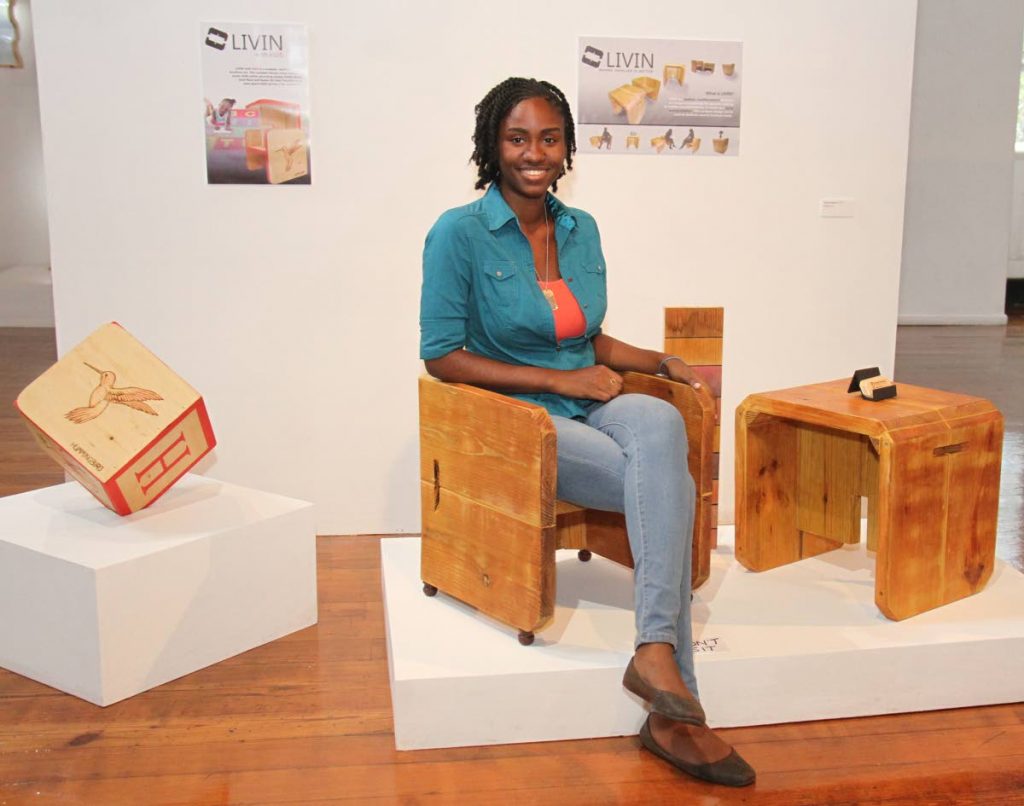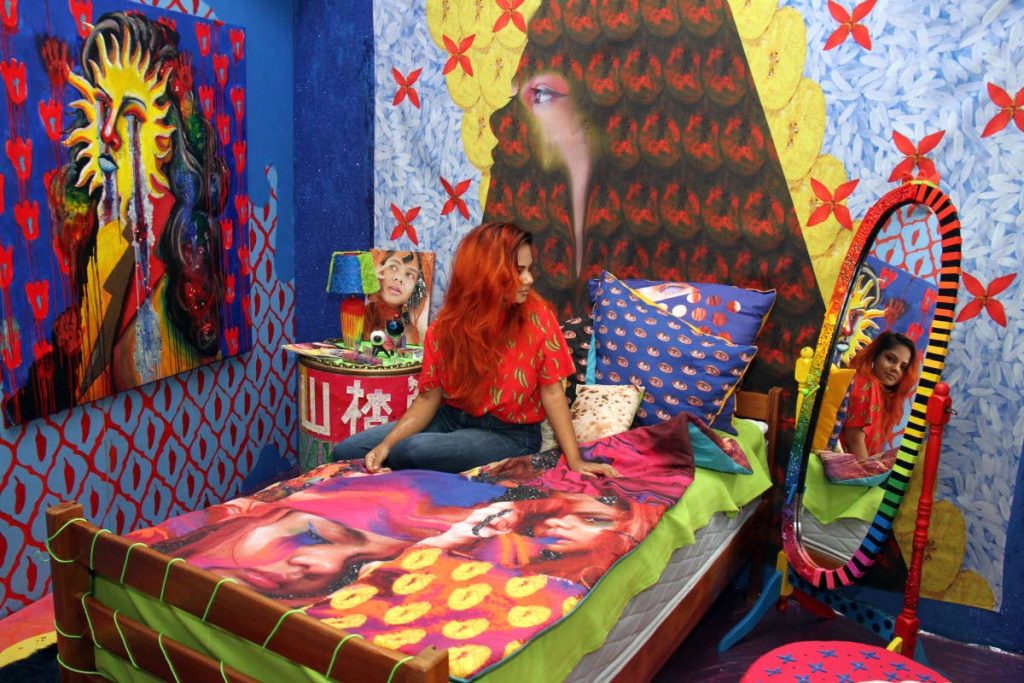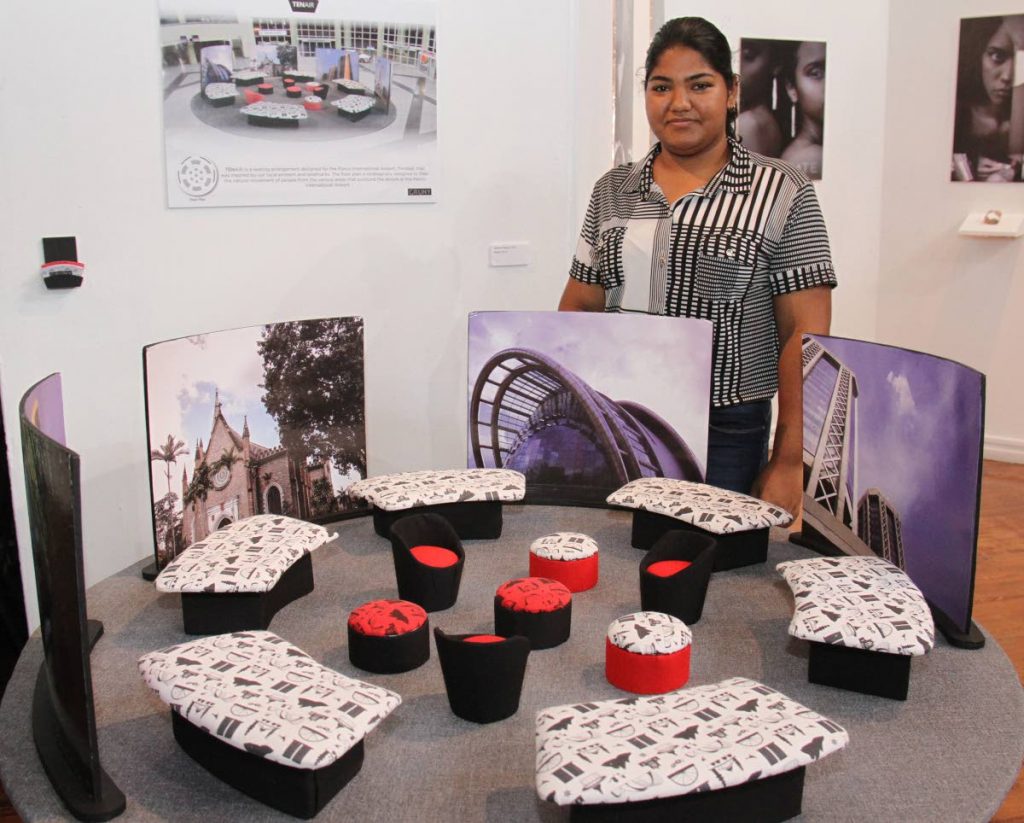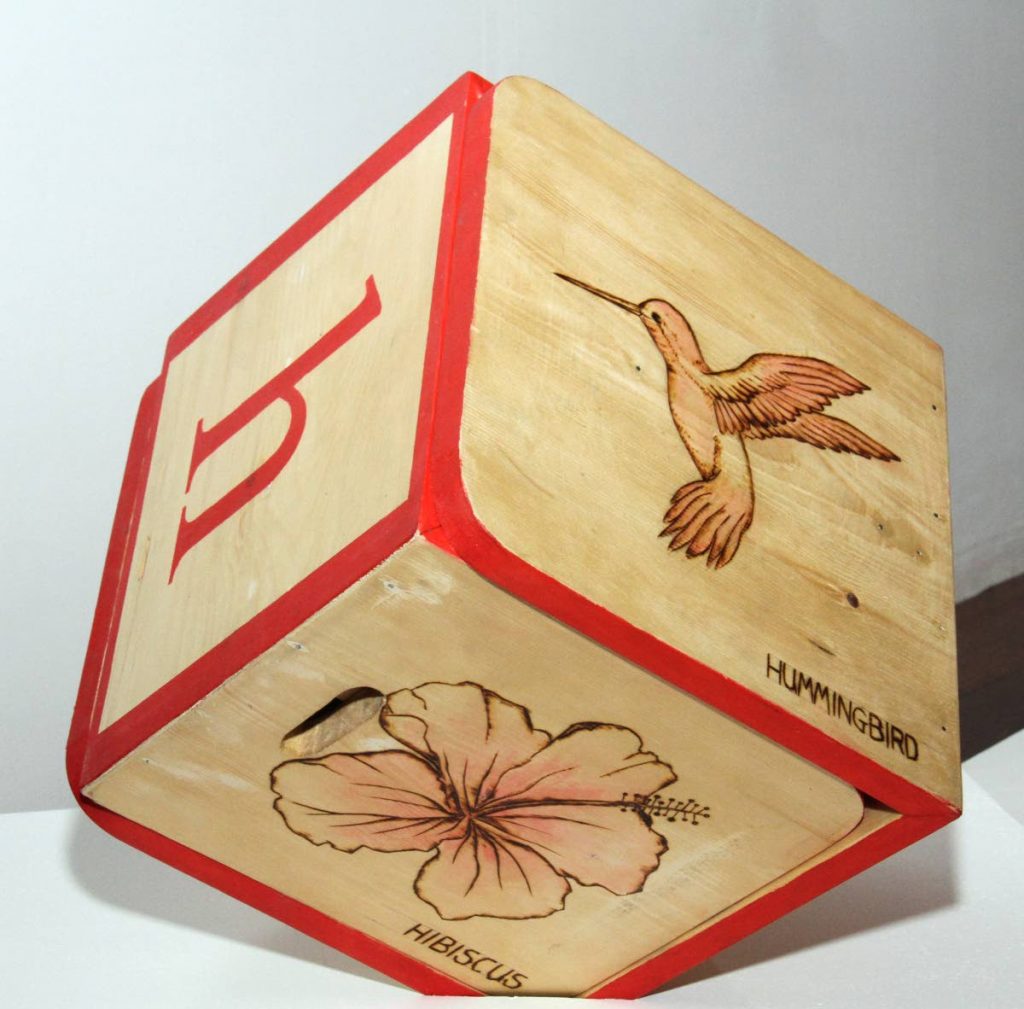Students shine at UWI degree show

A design for the airport’s atrium, contemplations on death, functional and minimalistic furniture, origami wirebending, furniture inspired by gingerbread-house fretwork, and a room dedicated to bipolar disorder are among the pieces of artwork on display at the National Museum and Art Gallery, Keate Street, Port of Spain.
They’re all part of the University of the West Indies’ (UWI) Degree Exhibition. Usually, the Department of Creative and Festival Art’s (DCFA) has this exhibition only for the fine-arts students, but the design students insisted their work should go on display also.
In the fine arts section, 17 students showed off their work on a range of topics including technology and the digital era.
Among them, Jeanice Briggs describes herself as a happy person who loves to paint colourful pieces. However, her final-year piece, Self, was a dark representation of the inner turmoil and tug of war she experiences with self-love and self-hate. She described herself as a competitive person who was active in her church and modelled as a teen, yet her friends and family did not know about her struggles with depression. She used rope, tar and splintered glass to create her 19-foot-six-inch display. Describing Self as a therapy piece, Briggs said her process was difficult and painful. She frequently cut herself on the shards of glass.
“I relate to my work in so many ways. With the rope, I always used to be on the field for a tug of war – for a tug of war in my mind between these two opposite emotions dancing with each other, making me have a lot of mixed emotions about myself...I had to go back and ask myself, when did I make the decision to change something drastically about myself that I did not like?”

She said that moment came when she was in form one and wanted to relax her hair because she wanted to conform to the conventional western standards of beauty with long, flowing, “soft” hair. The plaited rope became a symbol of the braids she wore as a child and the hate she felt for herself.
Marinna Shareef has bipolar disorder. She created The Attack, an immersion room which uses most of the senses to describe how she feels when she experiences an episode.
“The Attack is a bipolar simulation experience. It aims to use a bedroom as a simulator as I guide you through my mind when I have a mixed episode. A mixed episode is when you experience mania and depression at the same time. It can be very self-destructive, very hallucinogenic, and it is really hard to explain what it is like, which is why I decided to use visuals and sound as well as light to simulate it so other people could understand. People don’t really understand what bipolar disorder is like.”
Outside the bipolar bedroom, there is a speaker with a low hum and the popping sounds of bubble wrap. She said during her manic periods she pops bubble wrap to calm her down. Shareef said in Trinidad there is a lot of stigma towards the mentally ill and she hopes her piece could help others empathise with the attacks that people with bipolar disorder experience. Now that she’s graduated, Shareef intends to focus on her work and eventually further her fine-arts study at a university abroad. She wants to sell her painting and has already sold some of her work to her doctor.

Rachel Gangadeen’s anxiety inspired her work, The Exploration of Anxiety. She wound twine around her arm to show the restriction and pain her anxiety causes her, and then took photos in an attempt to capture the heaviness and panic she experiences because of anxiety.
Technology and its impact on society were among the themes tackled by the fine-arts students. Inspired by the digital era, they either turned within themselves to look at a behaviour characterised by their generation or used postmodern philosophy to theorise what impact technology has on society.

Jean Baudrillard’s Simulacra and Simulations inspired Tristan Edwards’ interrogation of hyperreality in his piece Façade. Hyperreality is the inability to distinguish reality from a simulated reality,
particularly in a technological society which has a fragmentation of stories and realities. Edwards’ work was a critique of the digital world and the impact screens have on humanity, showing the malleable and fluidity of life in the hyperreal.
Sydney De La Rosa critiqued “selfie culture” with her piece, the Narcissist. Utilising wirebending, she crafted skulls from multiple angles, similar to the way people make themselves appear in selfies.

She said she did research on narcissism and linked it to selfie culture and how people are obsessed with themselves, their faces and how they shape themselves to appease the societal standard of beauty.
“I did a bit of introspection, thinking about what is beauty and how far does beauty go, and to me, beauty is something that is not skin deep. It is further than what we have on the outer layer of ourselves, based on our personalities, and when I linked it to the selfie culture, a selfie is mostly of the face. That is what I focused on, the face and the internal part of the face. Underneath the face lies the skull.”
Many think an art degree is not practical, but the 12 students in the design programme showed art can be both aesthetically pleasing and practical.
Andrea Gruny thought Piarco Airport needed some local culture, so she designed Tenair, a seating arrangement that allows visitors to become acquainted with the sights and buildings of the country.

Tenair stands for tenor pan and airport as the layout is a pan. Gruny used local elements such as the national colours, the pan, the Trinity Hills, the St Joseph Mosque and the national birds. She created a fabric with prints from local landmarks and around the seating area there are pictures of contemporary buildings such as Napa and the Twin Towers and tourist attractions such as Toco Lighthouse, Pigeon Point, Bamboo Cathedral and the Avocat Waterfalls.
“In TT we lack a space that tourists can interact with. Most of the more modern countries in the world are incorporating culture into their space. What I wanted to do was bring this space into Trinidad so we would have something that represents us,” she said.
Gruny hopes to approach the Airport Authority with her Tenair plans.
Jonathan Crevelle designed fabric inspired by Tobago called Iconulture. Papa Bois, an abstract print of Mama D’L’Eau and crab and goat race were among his fabric designs.
“The aim was to find different ways of preserving culture. People used to tell stories, especially folklore, and I believe that fabric is an important part of us who we are and it can be integrated in almost everything. The clothes we wear are fabric. When we decorate stages, we use fabric. Why not use fabric that tells the story?”
He presented the Mama D’L’Eau fabric to someone in the Tobago House of Assembly, who liked it. He hopes to design clothes with that fabric and have someone at the Tobago Heritage Festival wear the outfit.
Crevelle does not want to limit himself to Tobago but create cultural expressions throughout the Caribbean on fabric.
Seeing a need to create jewellery that was not just decorative but functional, Zára Montoute created BlueNote, which allows women to store money in their earrings, bracelets, and chains.
“I saw the need for jewellery that could hold money because I personally found it difficult to find a nice handbag or purse when I am going out. Sometimes we don’t always want a bag. So I decided to give jewellery that functional purpose. It could be big and it could be small, When it is big there is so much room that is wasted,” she said.
LORE is a video game aimed at exposing children to the country’s folklore characters. Designed by Christopher Gonzales, LORE is a story about a boy who gets magically transported into a forest and must search for a way back home. Through his adventure, the boy discovers characters such as Papa Bois and Douens. Tenika Samuel designed Livin, a multifunctional furniture set designed to save space for people living in small spaces. She created a cube which can be pulled apart to make a table and chair or two chairs. She also has a children’s line called Livin with Kids, which looks like a children’s letter block. One side has an h, then a hibiscus and a hummingbird.
Samuel said Livin with Kids appears more popular with her audience. She hopes to build all the letters of the alphabet and hopes to turn her final-year project into a business. She said the children’s cube would cost $350 and the adult cube $1,000. However, she worries people would not want to pay for the cube if they could buy a plastic chair more cheaply. She said the wood alone cost $600. She and her father built the cube themselves, so there’s no labour fee attached, but the effort and design, she believes, are worth the price.
The show runs at the National Museum till June 29.

Comments
"Students shine at UWI degree show"